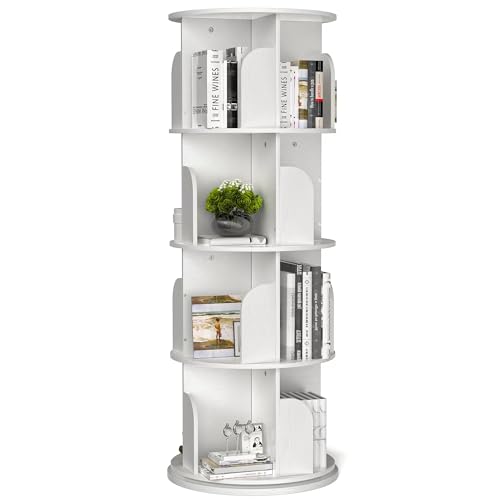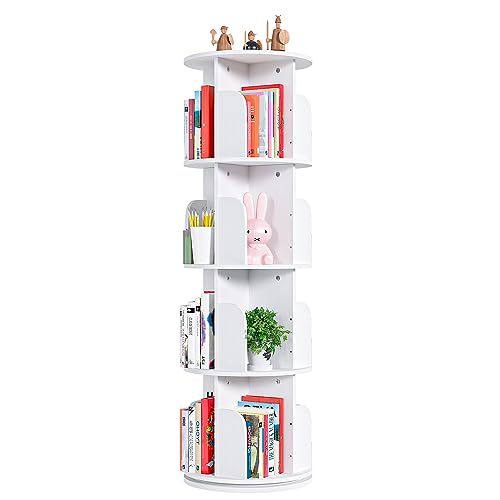Children’s Rotating Bookshelf Ideas: The 10 Trending Design & DIY
In the world of children’s literature, a rotating bookshelf isn’t just a piece of furniture, but it’s a magical gateway to adventure. A rotating bookshelf does add an element of excitement and playfulness to any child’s room.
But beyond the whimsy, these bookshelves serve a practical purpose. They encourage young readers to engage with books, fostering a lifelong love of reading. Plus, they keep those beloved stories organized and within easy reach.
In this article, we’ll explore the trending rotating bookshelf ideas that blend functionality with creativity. Whether you’re a parent, teacher, or bookworm, get ready to spin your way to literary bliss!
So, whether you’re a DIY enthusiast or simply want to enhance your child’s reading nook, these rotating bookshelves are a delightful addition.

The 10 Revolving Bookshelves Ideas for Children’s Rooms in 2024
Here are 10 trending rotating bookshelf ideas designed for children’s rooms, combining functionality, uniqueness, and space-saving features:
Trofast Rotating Bookshelf Hack

- Create a DIY rotating bookshelf using an IKEA Trofast frame and spice racks.
- Assemble the Trofast frame and spice racks, securing them to the outside of the frame.
- Add a lazy Susan bearing plate for smooth rotation.
- This functional and affordable solution allows easy access to books while saving space.
Floating Carousel Bookshelf
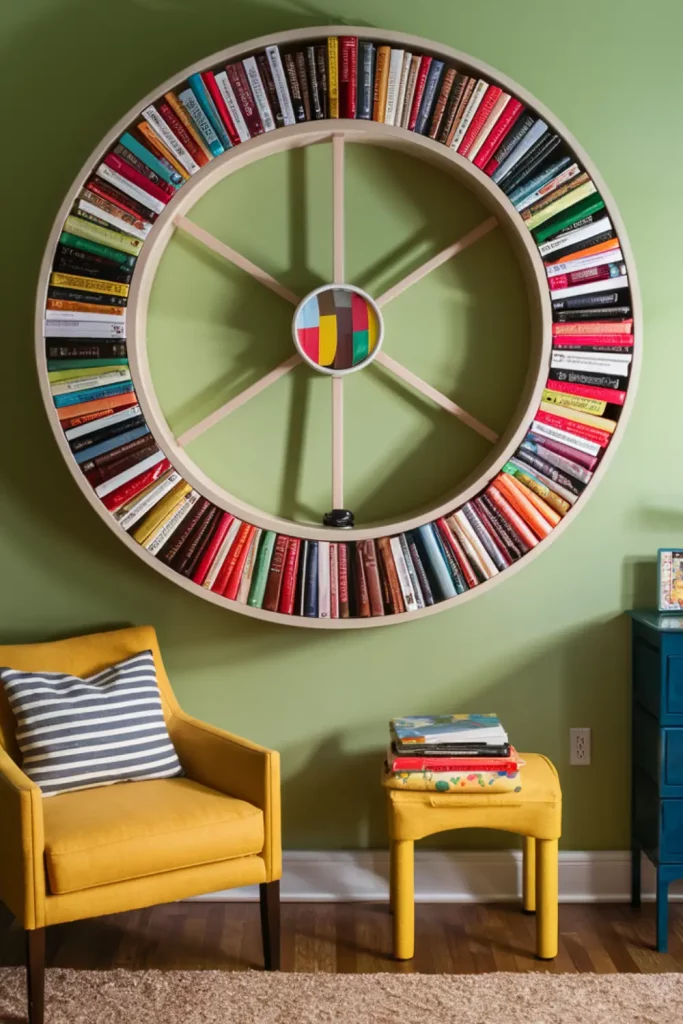
- Install a circular bookshelf on the wall, resembling a carousel.
- Arrange books vertically around the circle for easy browsing.
- Use colorful shelves to add a playful touch.
Treehouse Bookshelf
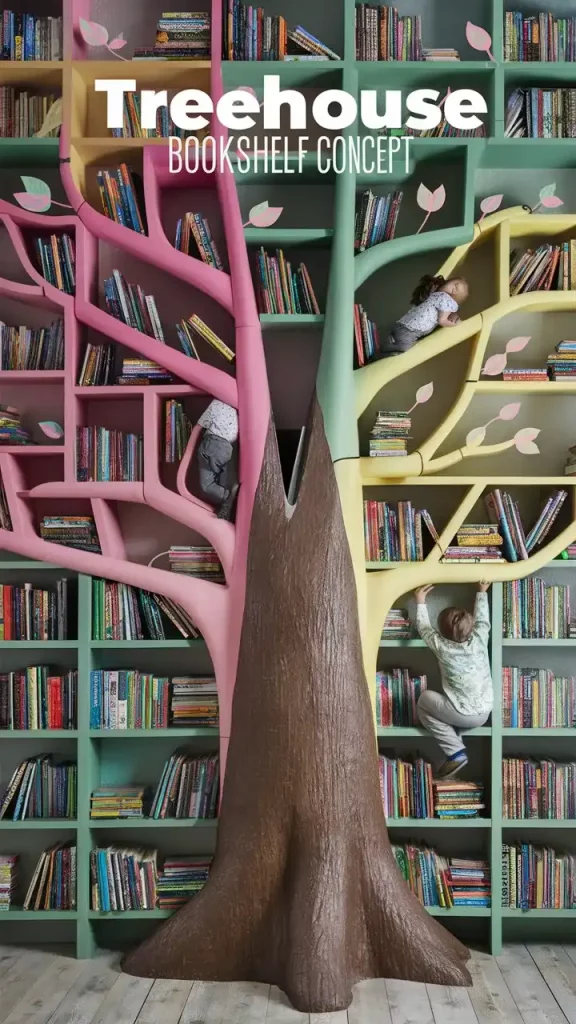
- Craft a tree-shaped bookshelf with branches as shelves.
- Paint it in vibrant colors and add leaves for a whimsical look.
- Kids can pick books from different branches.
Hexagonal Rotating Bookcase
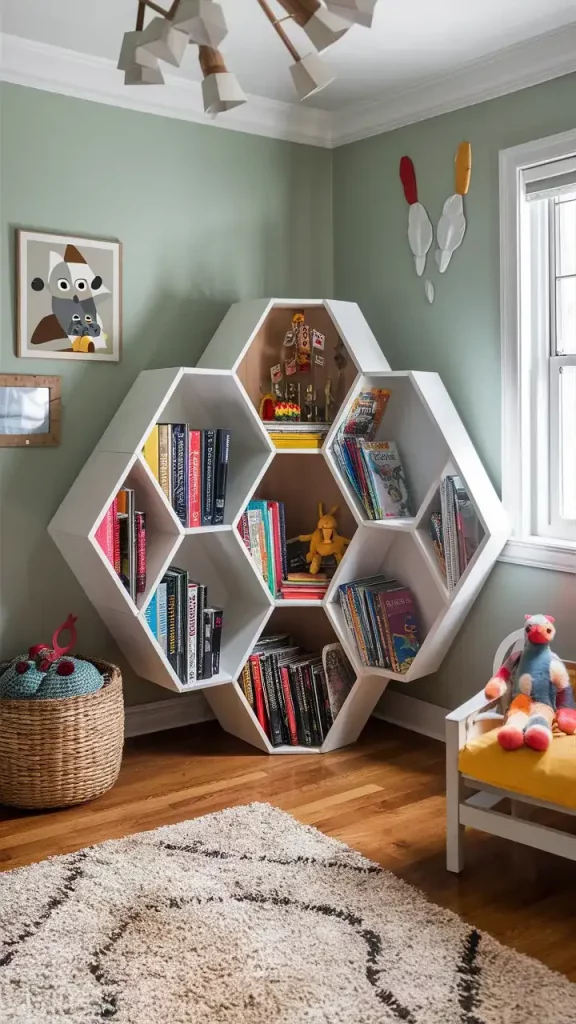
- Build a hexagonal bookshelf with rotating compartments.
- Each section can hold books or toys.
- Ideal for small spaces and adds a geometric flair.
Tiered Rotating Book Tower
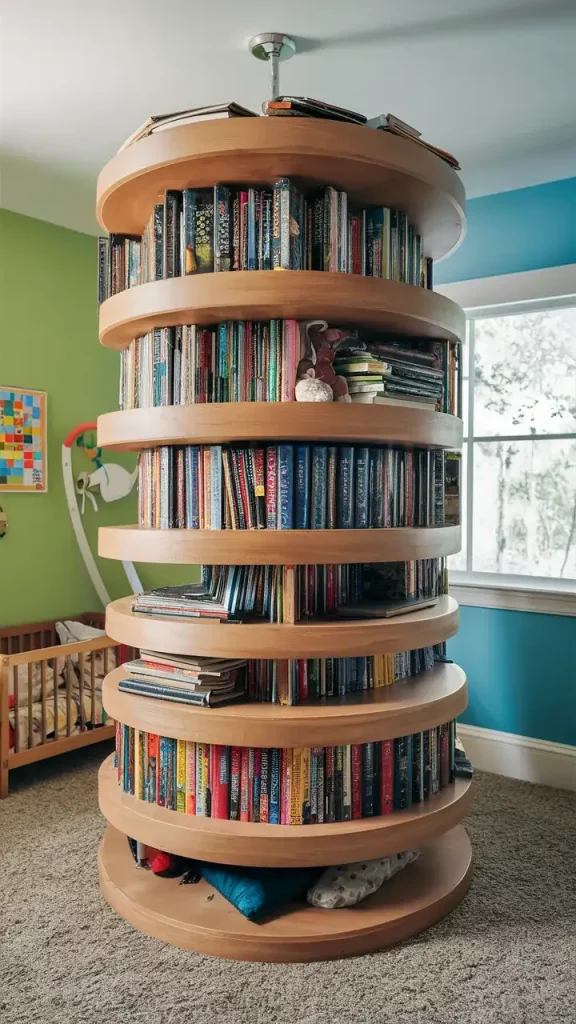
- Construct a tiered tower with rotating levels.
- Each level can accommodate books, puzzles, or art supplies.
- Rotate to access different sections easily.
Rocket Ship Bookshelf
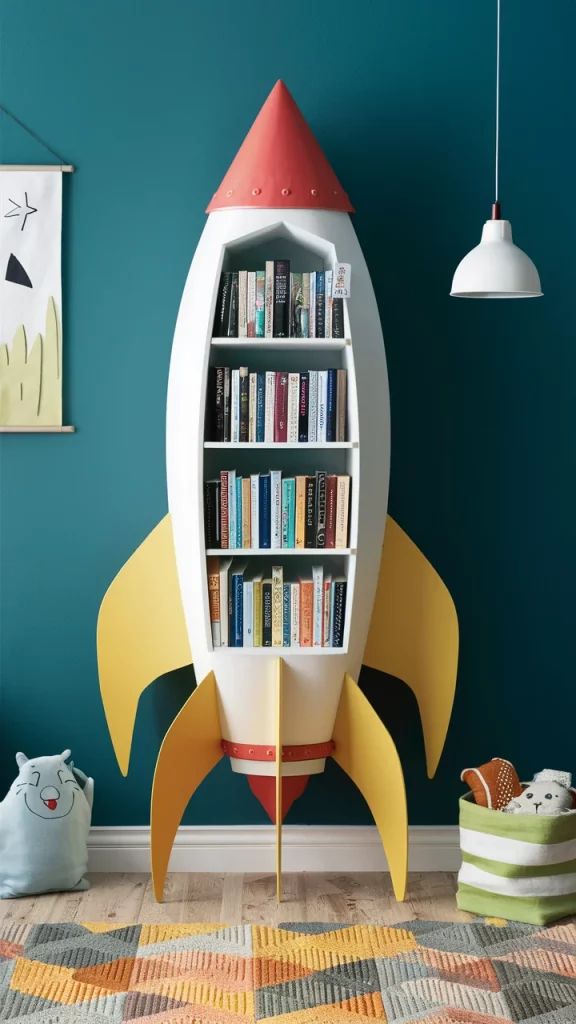
- Design a rocket-shaped bookshelf.
- Stack books vertically inside the rocket body.
- Add fins and a nose cone for a playful touch.
Colorful Spinning Cubes Bookcase
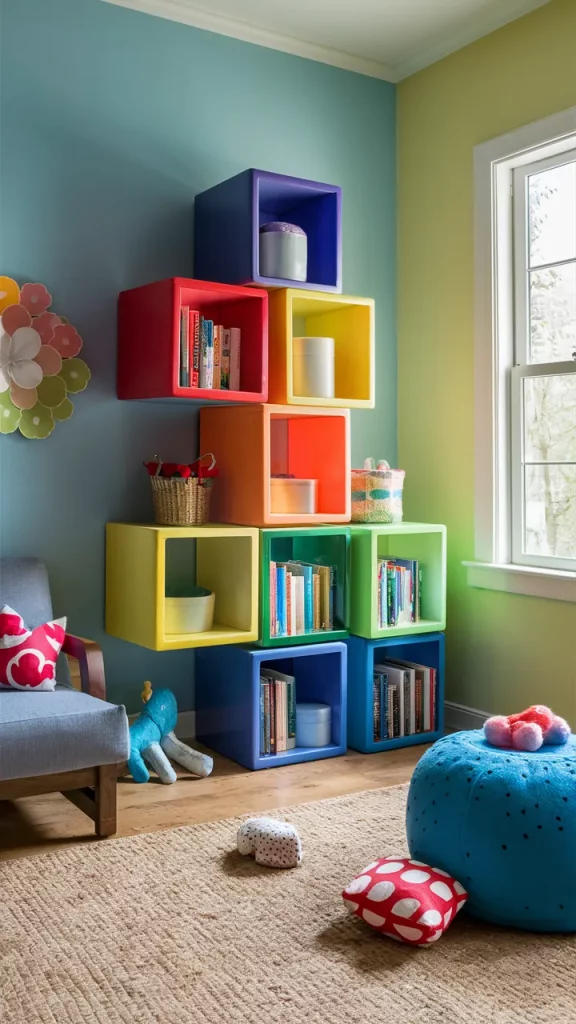
- Create individual cubes that rotate independently.
- Paint each cube in a different color.
- Arrange them in a stack or scatter them around the room.
Carousel Carousel Bookcase
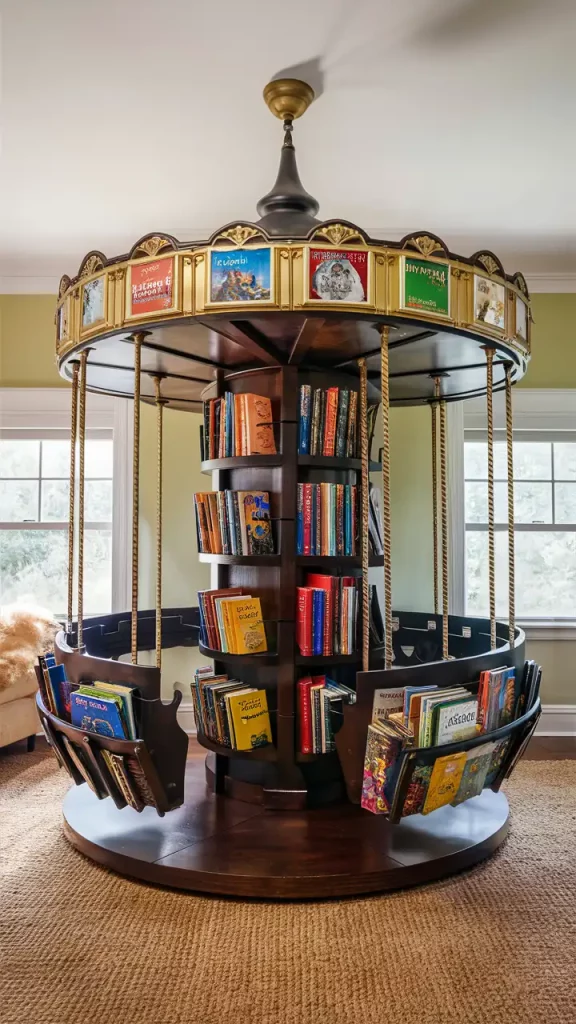
- Combine a carousel and a bookcase.
- Arrange bookshelves in a circular pattern.
- Kids can spin the entire unit to find their favorite books.
Rotating Corner Bookshelf
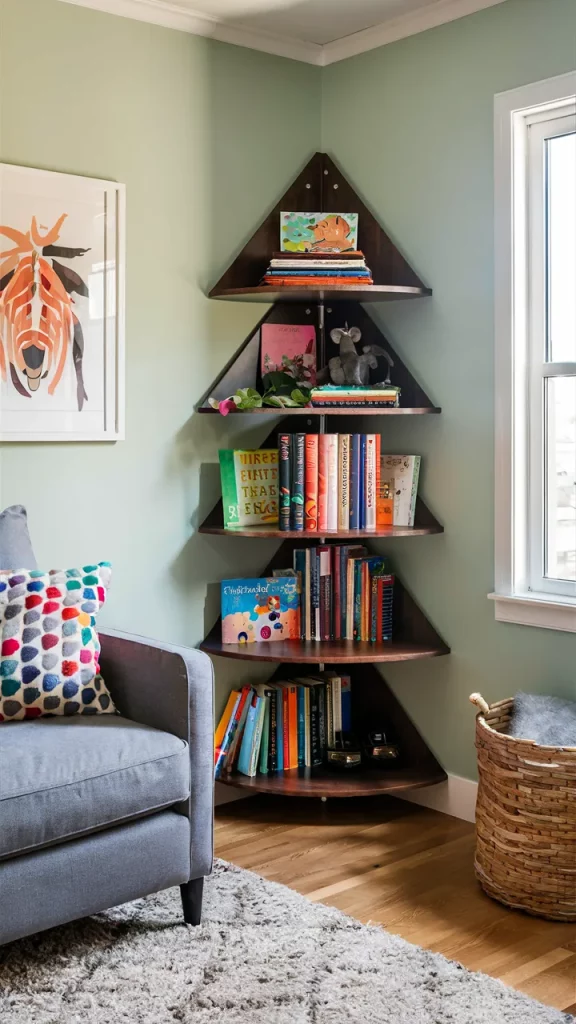
- Utilize corner space with a rotating bookshelf.
- Install triangular shelves that rotate smoothly.
- Perfect for bedtime stories in cozy corners.
Animal-Themed Rotating Shelves
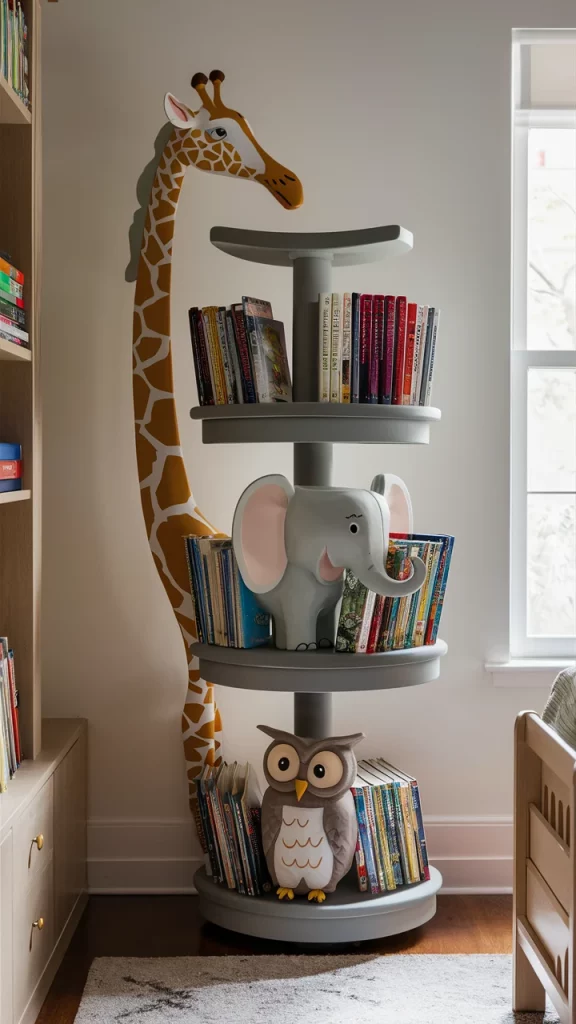
- Craft animal-shaped bookshelves (e.g., giraffe, elephant, or owl).
- Each shelf rotates independently.
- Kids will love the playful design and easy access.
Remember to choose materials and colors that match the room’s decor and consider safety features for young children.
How to Build a Children’s Rotating Bookshelf?
For children’s rotating bookshelf ideas, a DIY rotating bookshelf for a child’s room with efficient storage solutions can be a fantastic addition.
Constructed primarily of plywood using specific blades for precision, this project involves pocket-hole joinery for sturdy assembly.
The process includes making cuts, creating pocket holes, attaching dowels, and eventually assembling with the help of tools like a table saw, miter saw, and jigsaw.
The rotating bookshelf offers ample space for both books and toys, allowing for easy access and organization.
Additionally, printable plans are available for download, making this project achievable and rewarding for any DIY enthusiast.
Key Points:
- DIY rotating bookshelf can be a great addition to a child’s room with efficient storage solutions
- Constructed primarily of plywood using specific blades for precision
- Involves pocket hole joinery for sturdy assembly
- The process includes making cuts, creating pocket holes, attaching dowels, and eventually assembly with tools like a table saw, miter saw, and jigsaw
- Provides ample space for both books and toys, allowing for easy access and organization
- Printable plans are available for download, making the project achievable for DIY enthusiasts
Check this out:
DIY Rotating Bookshelf for Children’s Room
Plywood Bookshelf Basics
Plywood is the ideal choice for creating a rotating bookshelf in a children’s room due to its durability and versatility.
Choosing quality plywood is essential to ensure the bookshelf can withstand the wear and tear of young hands.
Affordable and easily accessible at hardware stores, plywood is a practical material for this project.
Opt for a smooth and defect-free plywood grade for a polished final appearance that blends with the room’s decor.
Blade Recommendations For Precision
To achieve precise cuts when working with plywood for your rotating bookshelf project, it is crucial to choose the right blades for your saws.
For cutting plywood, a high-quality carbide-tipped blade with at least 40 teeth is recommended to minimize splintering and ensure clean edges.
Additionally, using a blade specifically designed for plywood will help prevent tear-out and produce smoother cuts, resulting in a professional-looking finished product.
Invest in quality blades to make your cutting process more efficient and to achieve the desired outcomes for your DIY rotating bookshelf.
Pocket Hole Joinery Guide
Pocket hole joinery is a popular technique for assembling furniture pieces, including rotating bookshelves, due to its simplicity and strength.
When building your DIY rotating bookshelf, incorporating pocket holes will provide a secure and seamless connection between the different components of the bookshelf.
By using a pocket hole jig and screws, you can quickly create strong joints that will ensure the stability and longevity of your rotating bookshelf.
Practice creating pocket holes on scrap pieces of plywood before moving on to the actual project to perfect your technique and ensure precise results.
- Incorporating pocket holes in the assembly of furniture pieces adds strength and stability
- Practice creating pocket holes on scrap pieces of plywood before the actual project
- Using a pocket hole jig and screws ensures secure and long-lasting joints.
Cuts And Assembly Steps
The process of constructing a rotating bookshelf for a children’s room involves:
- Making precise cuts to the plywood panels and assembling the pieces using pocket hole joinery.
- Begin by carefully measuring and marking the plywood according to the specified dimensions in the plans.
- Utilize a table saw, miter saw, or jigsaw to make the necessary cuts, ensuring accuracy for a perfect fit during assembly.
- Create pocket holes in the appropriate locations to facilitate easy joining of the pieces.
- Assemble the bookshelf according to the provided instructions, ensuring correct alignment of the components for a seamless finish.
Tip: Take your time and follow the steps meticulously to achieve a well-constructed rotating bookshelf.
- Use a table saw, miter saw, or jigsaw to make the necessary cuts, ensuring accuracy for a perfect fit during assembly.
- Create pocket holes in the appropriate locations to facilitate easy joining of the pieces.
- Assemble the bookshelf according to the provided instructions, ensuring correct alignment of the components for a seamless finish.
- Take your time and follow the steps meticulously to achieve a well-constructed rotating bookshelf.
Utilizing Dowels For Stability
Incorporating dowels into the construction of your rotating bookshelf will enhance its stability and provide additional support for the shelves.
When attaching the shelves to the main structure of the bookshelf, consider using dowels in conjunction with screws for added reinforcement.
Dowels can help distribute weight evenly across the bookshelf, preventing sagging and ensuring that it remains sturdy over time.
Make sure to accurately drill dowel holes in both the shelves and the main frame to guarantee a perfect fit and a secure connection.
Essential Tools For Construction
Building a DIY rotating bookshelf for a children’s room involves using essential tools for accurate cuts and precise assembly. Key tools for this project include:
- Table saw for making straight cuts
- Miter saw for angled cuts
- Jigsaw for intricate shaping
- Pocket hole jig for strong joints
- Drill with the appropriate bits for drilling holes and driving screws
Investing in quality tools and maintaining them properly will ensure a smoother construction process and professional results.
Tools are essential for building a DIY rotating bookshelf.
- Table saw for straight cuts
- Miter saw for angled cuts
- Jigsaw for shaping
- Pocket hole jig for joints
- Drill for holes and screws
Maximizing Storage Space
When designing a rotating bookshelf for a children’s room, consider incorporating efficient storage solutions to maximize the available space for books and toys.
Adjustable shelves can accommodate items of various sizes, allowing for easy organization and customization based on the child’s preferences.
Utilizing the vertical space by incorporating multiple tiers of shelves will help optimize storage capacity without taking up additional floor space.
Incorporating compartments or bins within the rotating bookshelf can provide designated storage for different types of toys, keeping the room neat and organized.
Room For Books And Toys
A well-designed rotating bookshelf for a children’s room should offer ample space for books and toys, maintaining a visually appealing and functional layout.
By combining open shelves with enclosed storage compartments, you can create a versatile storage solution that accommodates a variety of items.
Consider designating areas for books, toys, and decorative elements to encourage organization and accessibility for the child.
The rotating feature of the bookshelf allows for easy access to all sides, making it convenient for children to browse and select items effortlessly.
Growing With Your Child
One of the advantages of creating a rotating bookshelf for a children’s room is its ability to adapt and grow with the child as they mature.
The ample storage space provided by the bookshelf allows for accommodating an expanding collection of books, toys, and other belongings over time.
As the child’s interests and preferences evolve, the rotating bookshelf can be rearranged and customized to reflect their changing tastes.
By investing time and effort into building a durable and functional rotating bookshelf, you can create a long-lasting piece of furniture that will remain relevant and useful throughout your child’s formative years.
FAQ
What is the revolving mechanism of a bookcase?
The revolving mechanism of a bookcase is ingeniously designed with two nesting cast iron cones that create a precise pivot point to support the weight of the entire bookcase.
This innovative top support suspension design effectively addresses the binding and racking issues that were common in previous Lazy Susan type bookcases with bottom bearings.
By utilizing this advanced mechanism, the bookcase can smoothly rotate and neatly display its contents without any structural limitations or risks of imbalance.
What is the purpose of a revolving bookcase?
A revolving bookcase serves as an efficient and space-saving solution for storing a significant number of books in a limited area.
By utilizing its rotating design, it maximizes storage capacity while occupying minimal floor space, making it ideal for compact living spaces or rooms with spatial constraints.
This innovative furniture piece allows book lovers to conveniently access their collection without compromising on style or functionality.
How do I make my kids bookshelf look nice?
To make your kids’ bookshelf look nice, you can organize the books by grouping them according to size or color of their spines.
This can create a visually appealing arrangement that is aesthetically pleasing. Additionally, incorporating special books, photos, or art pieces and leaning them against the back of the shelf or wall can add a personal touch and bring some visual interest to the bookshelf.
💡 Did You Know?
1. In Japan, a popular children’s rotating bookshelf idea is the “tawamurebookcase,” which translates to “playful bookshelf.” It features multiple tiers that can be spun around, making it easy for kids to access their favorite books.
2. The concept of a rotating bookshelf for children goes back to ancient Egyptian times, where wealthy families used revolving bookcases to store their scrolls and keep them organized.
3. The world’s largest rotating bookshelf for children is located in a public library in Singapore. It can hold over 1,000 children’s books and rotates on a motorized base controlled by librarians.
4. One innovative children’s rotating bookshelf idea is the “storybook carousel,” designed to look like a carousel at a fairground. Each bookshelf section spins independently, adding an element of fun and whimsy to the reading experience.
5. In some Montessori-inspired preschools, children’s rotating bookshelves are designed with different themes on each side, such as animals, shapes, or colors. This encourages children to explore a variety of topics and interests while selecting their next book to read.








